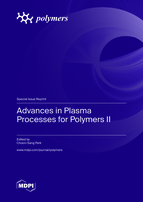Advances in Plasma Processes for Polymers II
A special issue of Polymers (ISSN 2073-4360). This special issue belongs to the section "Polymer Processing and Engineering".
Deadline for manuscript submissions: closed (28 April 2023) | Viewed by 18710
Special Issue Editor
Interests: atmospheric pressure plasma; microplasma jet device; plasma polymerization; solution plasma; bio applications; microdischarge; Dielectric Barrier Discharge (DBD); high-pressure plasma; plasma thruster; ion propulsion; flexible microplasma thruster; plasma cancer therapy; plasma endodontics; Polymer Light-Emitting Diodes (PLEDs); short-time and long-time (life time) discharge characteristics of plasma display panel and plasma devices
Special Issues, Collections and Topics in MDPI journals
Special Issue Information
Dear Colleagues,
Polymerized nanoparticles and nanofibers can be prepared using various processes, such as chemical synthesis, the electrochemical method, electrospinning, ultrasonic irradiation, hard and soft templates, seeding polymerization, interfacial polymerization, and plasma polymerization. Among these processes, plasma polymerization and aerosol-through-plasma (A-t-P) processes have versatile advantages, especially due to having a “dry” process, for the deposition of plasma polymer films and carbon-based materials with functional properties suitable for a wide range of applications, such as electronic and optical devices, protective coatings, and biomedical materials. Furthermore, it is well known that plasma polymers are highly cross-linked, pinhole-free, branched, insoluble, and adhere well to most substrates. In order to synthesize polymer films using plasma processes, therefore, it is very important to increase the density and electron temperature of plasma during plasma polymerization.
This Special Issue aims to compile original and cutting-edge research works in the fields of plasma process, polymerization, synthesis, characterization, treatment, modification, manufacturing, and applications of functional plasma-processed polymers.
Dr. Choon-Sang ParkGuest Editor
Manuscript Submission Information
Manuscripts should be submitted online at www.mdpi.com by registering and logging in to this website. Once you are registered, click here to go to the submission form. Manuscripts can be submitted until the deadline. All submissions that pass pre-check are peer-reviewed. Accepted papers will be published continuously in the journal (as soon as accepted) and will be listed together on the special issue website. Research articles, review articles as well as short communications are invited. For planned papers, a title and short abstract (about 100 words) can be sent to the Editorial Office for announcement on this website.
Submitted manuscripts should not have been published previously, nor be under consideration for publication elsewhere (except conference proceedings papers). All manuscripts are thoroughly refereed through a single-blind peer-review process. A guide for authors and other relevant information for submission of manuscripts is available on the Instructions for Authors page. Polymers is an international peer-reviewed open access semimonthly journal published by MDPI.
Please visit the Instructions for Authors page before submitting a manuscript. The Article Processing Charge (APC) for publication in this open access journal is 2700 CHF (Swiss Francs). Submitted papers should be well formatted and use good English. Authors may use MDPI's English editing service prior to publication or during author revisions.
Keywords
- low-pressure plasma
- atmospheric pressure plasma
- plasma process
- plasma polymerization
- plasma synthesis
- plasma deposition
- dielectric barrier discharge
- fragmentation
- recombination
- polymer
- conductive polymer
- copolymer
- plasma treatment
- surface modification
- large area treatment and deposition







